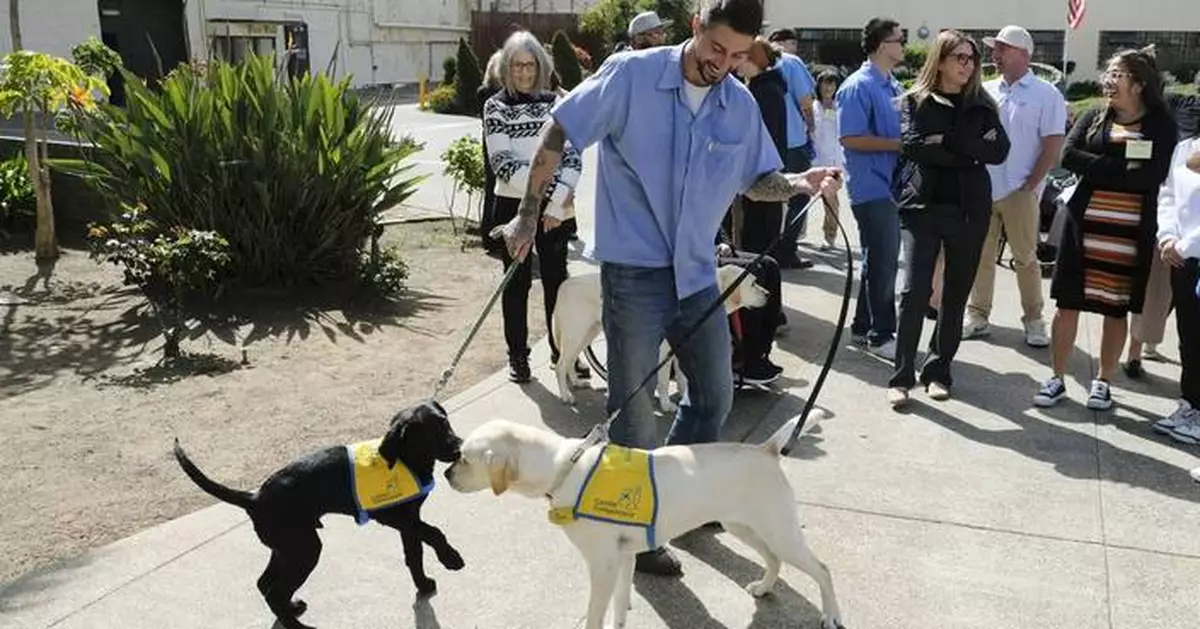SAN QUENTIN, Calif. (AP) — Hugs, tears, barking and tail wagging abounded at San Quentin’s prison when two black Labradors reunited with the incarcerated men who helped raise them to be service dogs.
The emotional reunion brought together Chase Benoit, Jared Hansen and the 2-year-old dogs they helped train: Wendel and Artemis. It was the men's first time seeing their former canine companions again and their first time meeting the dogs' disabled handlers in person.
Click to Gallery
Benjamin Carter, in a wheelchair, with his service dog Artemis, and Robert Quigley, who is deaf, with his service dog Wendel, go through a secure entryway into the San Quentin Rehabilitation Center in San Quentin, Calif., Friday, March 28, 2025. (AP Photo/Eric Risberg)
Artemis, a service dog, is seen by the wheelchair of handler Benjamin Carter at the San Quentin Rehabilitation Center in San Quentin, Calif., Friday, March 28, 2025. (AP Photo/Eric Risberg)
Incarcerated men at the San Quentin Rehabilitation Center do a demonstration with the dogs they are raising during a celebration in San Quentin, Calif., Friday, March 28, 2025. (AP Photo/Eric Risberg)
Jared Hansen, right, and other incarcerated men at the San Quentin Rehabilitation Center hold up their dog training certificates during a celebration in San Quentin, Calif., Friday, March 28, 2025. (AP Photo/Eric Risberg)
Handler Benjamin Carter looks at his service dog Artemis during a gathering at the San Quentin Rehabilitation Center in San Quentin, Calif., Friday, March 28, 2025. (AP Photo/Eric Risberg)
Artemis, a service dog, is seen by the wheelchair of handler Benjamin Carter at the San Quentin Rehabilitation Center in San Quentin, Calif., Friday, March 28, 2025. (AP Photo/Eric Risberg)
Incarcerated men at the San Quentin Rehabilitation Center pet a service dog in training at the prison in San Quentin, Calif., Friday, March 28, 2025. (AP Photo/Eric Risberg)
Jared Hansen, who is incarcerated at the San Quentin Rehabilitation Center, is greeted by Artemis, a service dog he helped train, in San Quentin, Calif., Friday, March 28, 2025. (AP Photo/Eric Risberg)
Jared Hansen, right, who is incarcerated at the San Quentin Rehabilitation Center, visits with Artemis as his handler, Benjamin Carter, looks on in San Quentin, Calif., Friday, March 28, 2025. (AP Photo/Eric Risberg)
Benjamin Carter, in a wheelchair, with his service dog Artemis, and Robert Quigley, who is deaf, with his service dog Wendel, go through a secure entryway into the San Quentin Rehabilitation Center in San Quentin, Calif., Friday, March 28, 2025. (AP Photo/Eric Risberg)
Chase Benoit, who is incarcerated at the San Quentin Rehabilitation Center, holds a pair of service dogs in training in San Quentin, Calif., Friday, March 28, 2025. (AP Photo/Eric Risberg)
The encounter Friday in San Quentin’s main courtyard brought Benoit and Hansen full circle after helping launch the prison’s puppy training program in April 2023.
“Being in this program, it’s given me something that I think I’ve searched for my whole life,” said Benoit, who is serving 15 years-to-life for second-degree murder. “And that was meaningful purpose, doing something that’s good, better, bigger than myself and feeling like I’m part of something great.”
Robert Quigley, who is deaf, teared up after seeing his spirited dog Wendel bark and get excited when he saw Benoit, his old trainer.
“He remembers me, for sure, I could tell when he came in. I’m so happy that you love him, and that you have a bond,” Benoit told Quigley through an American Sign Language interpreter.
“He’s with me 24/7. He’s very gentle and good with people,” answered Quigley, a recent college graduate who took Wendel home in November after the black Labrador and golden retriever mix completed another six months of professional training outside prison.
Benoit and Jensen were part of an initial group of four incarcerated trainers who shared their 4 foot-by-10 foot cells with the 4-month-old puppies. The men divided the responsibility of caring for and teaching the dogs foundational commands for a year.
Canine Companions, a nonprofit based in Santa Rosa, runs the program and provides free service dogs to people with disabilities. It has built the San Quentin program to 16 trainers and two dog sitters who, as of this week, are training eight puppies.
Artemis, a black Labrador, was matched with Benjamin Carter, a veterinarian from Portland, Oregon, who uses a wheelchair, and traveled to California for the reunion.
Like proud parents, Carter and Hansen shared notes on Artemis' calm and loving personality and penchant for cuddles.
“Seeing him in action and actually serving somebody in the community, it’s just … I’m at a loss for words right now. It’s amazing!” said Hansen, who has been in prison for 15 years for bank robbery.
Artemis, or Artie, pushes door plates, pulls doors open, fetches things around the house and does many other tasks that would be hard for Carter alone.
“He is responsive when he’s working. He is cuddly when he is off the clock. He’s an amazing companion. And all that structure and love and trust was built from these guys here, so I’m just super grateful to them,” Carter said.
The puppies are placed with incarcerated trainers when the dogs are between 2 and 4 months of age and stay with them until they are about 16 to 17 months old. Every three months the puppies are taken out for socialization experiences like interacting with children, riding in cars or going to the grocery store.
The incarcerated men teach them about 20 skills, including fetching, sitting and walking on a leash. After the dogs leave the prison, they train for several more months with professional trainers.
People incarcerated at San Quentin and who participate in the program have been convicted of crimes that include bank robberies, gun offenses and murder. Only those who are in an “earned living unit,” where residents participate in an array of self-help programs, are allowed to apply for puppy training. Inmates with records that include any animal or child cruelty crimes are not allowed to participate, said James Dern, national director of puppy programs for Canine Companions.
Dern said dogs trained in their prison programs have a 10% greater success rate at becoming service dogs than other candidates because of the amount of time and care that incarcerated puppy raisers put into their dogs.
“Being given something to care about other than themselves and the opportunity to give back and to sort of start to make amends for the things they have done in their lives can be life changing,” Dern said.
San Quentin was once home to the largest death row population in the United States. The puppy training program started the year it transformed into a lockup where less-dangerous prisoners receive education, training and rehabilitation. Since then, another 11 correctional facilities have joined the nonprofit for a total of 24 prison institutions, Dern said.
Speaking to a crowd at the prison chapel gathered to celebrate the program, Benoit credited Canine Companions with bringing out the humanity, love and caring in the incarcerated community. "Instead of keeping it to themselves within their small community of professional trainers or even volunteer puppy raisers, they shared this with us in prison and I think that’s huge,” he said.

Artemis, a service dog, is seen by the wheelchair of handler Benjamin Carter at the San Quentin Rehabilitation Center in San Quentin, Calif., Friday, March 28, 2025. (AP Photo/Eric Risberg)

Incarcerated men at the San Quentin Rehabilitation Center do a demonstration with the dogs they are raising during a celebration in San Quentin, Calif., Friday, March 28, 2025. (AP Photo/Eric Risberg)
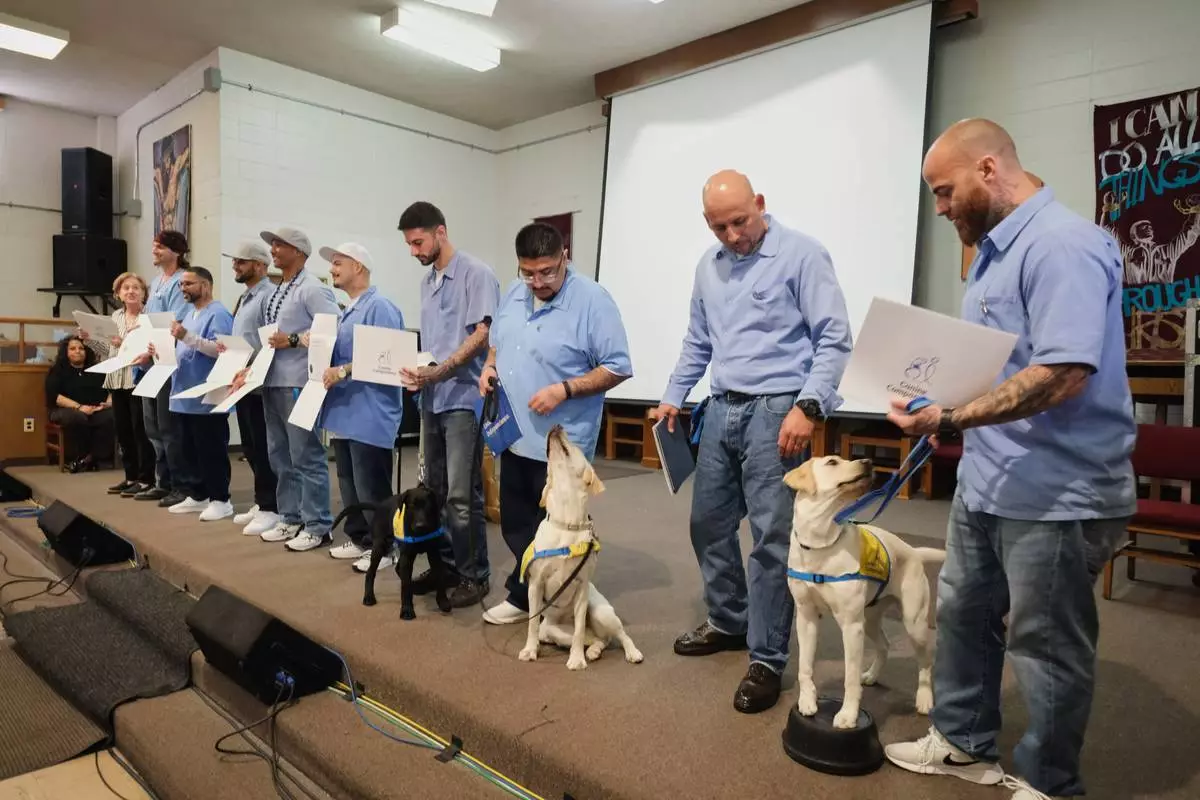
Jared Hansen, right, and other incarcerated men at the San Quentin Rehabilitation Center hold up their dog training certificates during a celebration in San Quentin, Calif., Friday, March 28, 2025. (AP Photo/Eric Risberg)
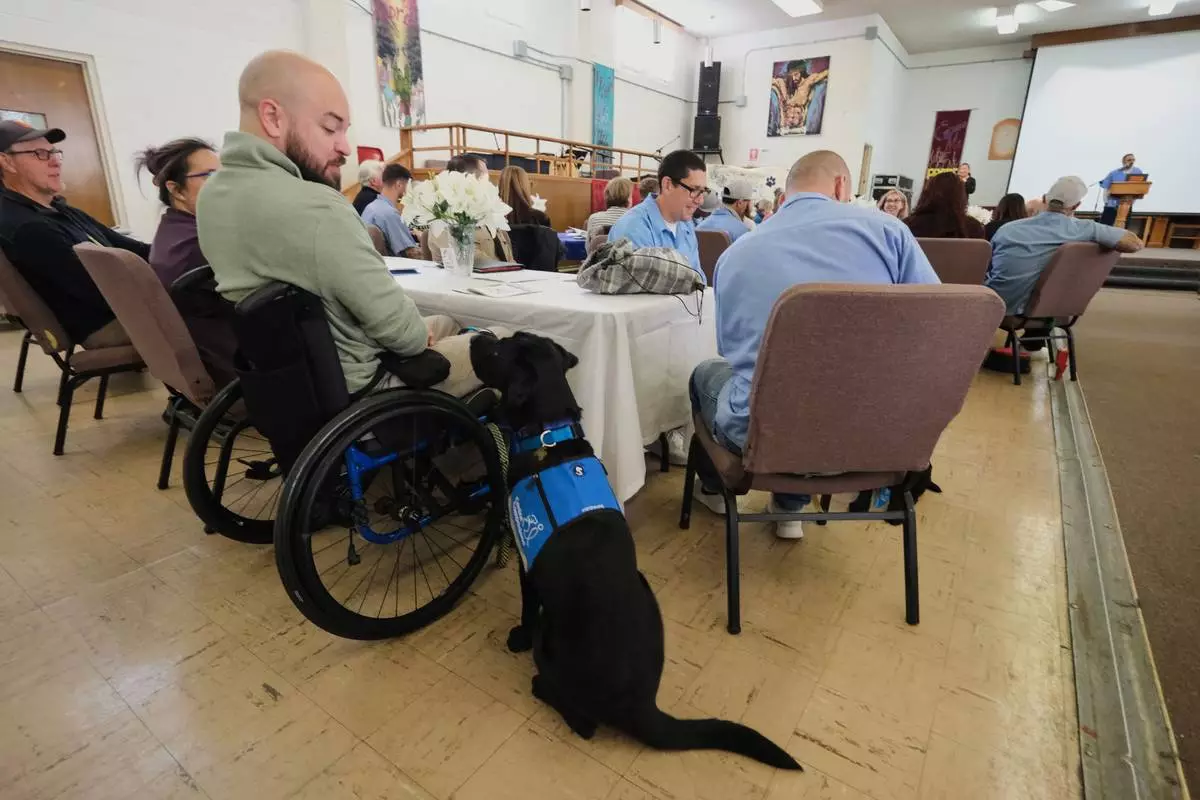
Handler Benjamin Carter looks at his service dog Artemis during a gathering at the San Quentin Rehabilitation Center in San Quentin, Calif., Friday, March 28, 2025. (AP Photo/Eric Risberg)
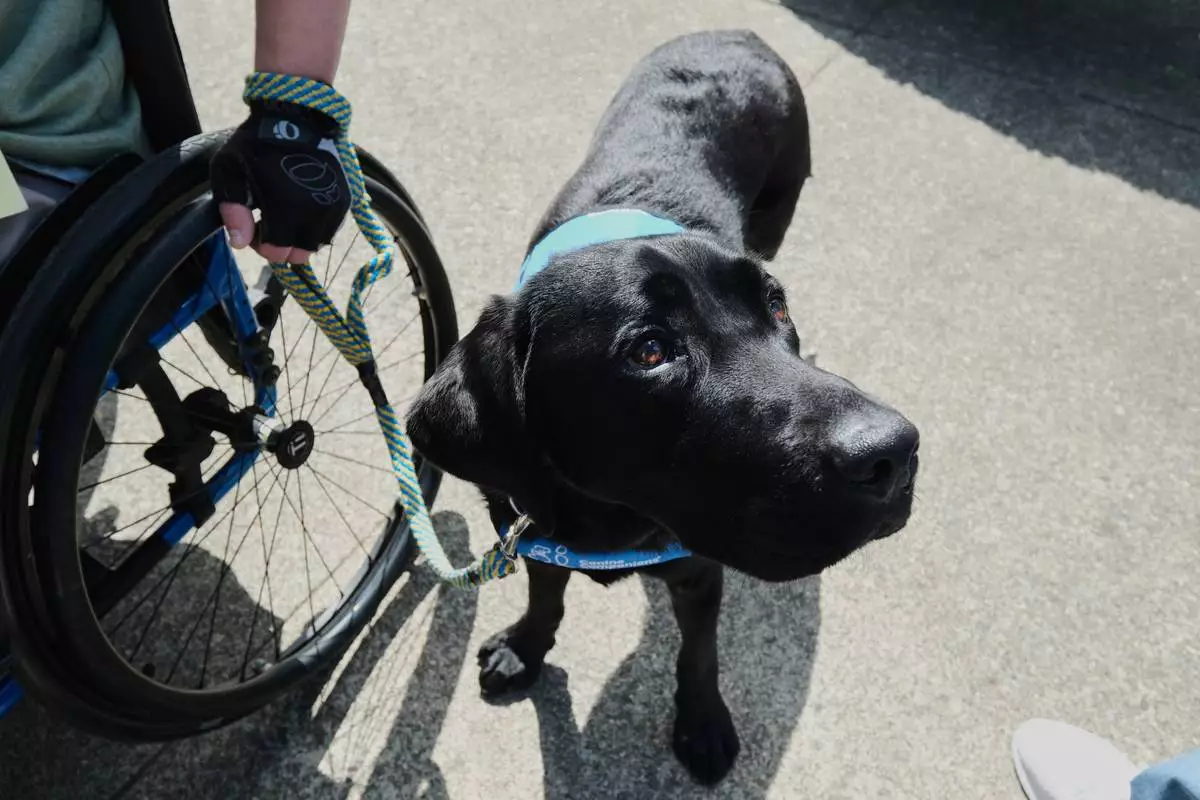
Artemis, a service dog, is seen by the wheelchair of handler Benjamin Carter at the San Quentin Rehabilitation Center in San Quentin, Calif., Friday, March 28, 2025. (AP Photo/Eric Risberg)
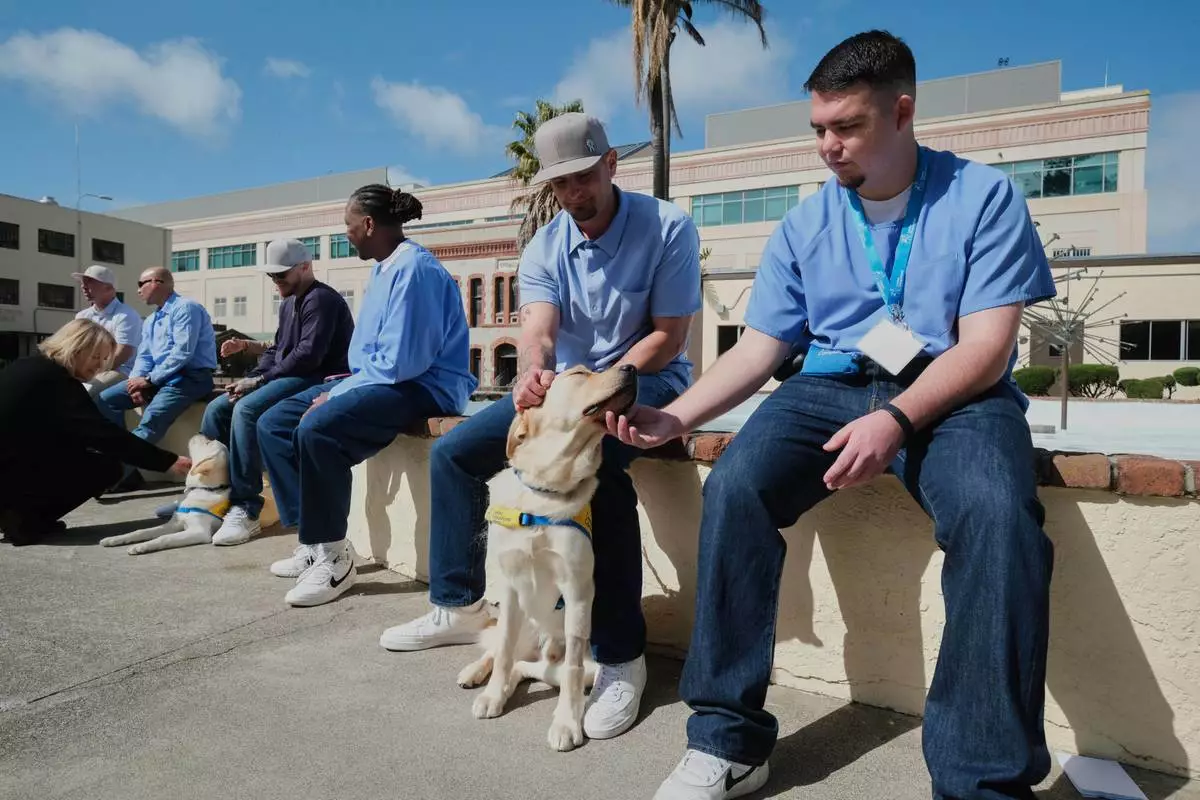
Incarcerated men at the San Quentin Rehabilitation Center pet a service dog in training at the prison in San Quentin, Calif., Friday, March 28, 2025. (AP Photo/Eric Risberg)
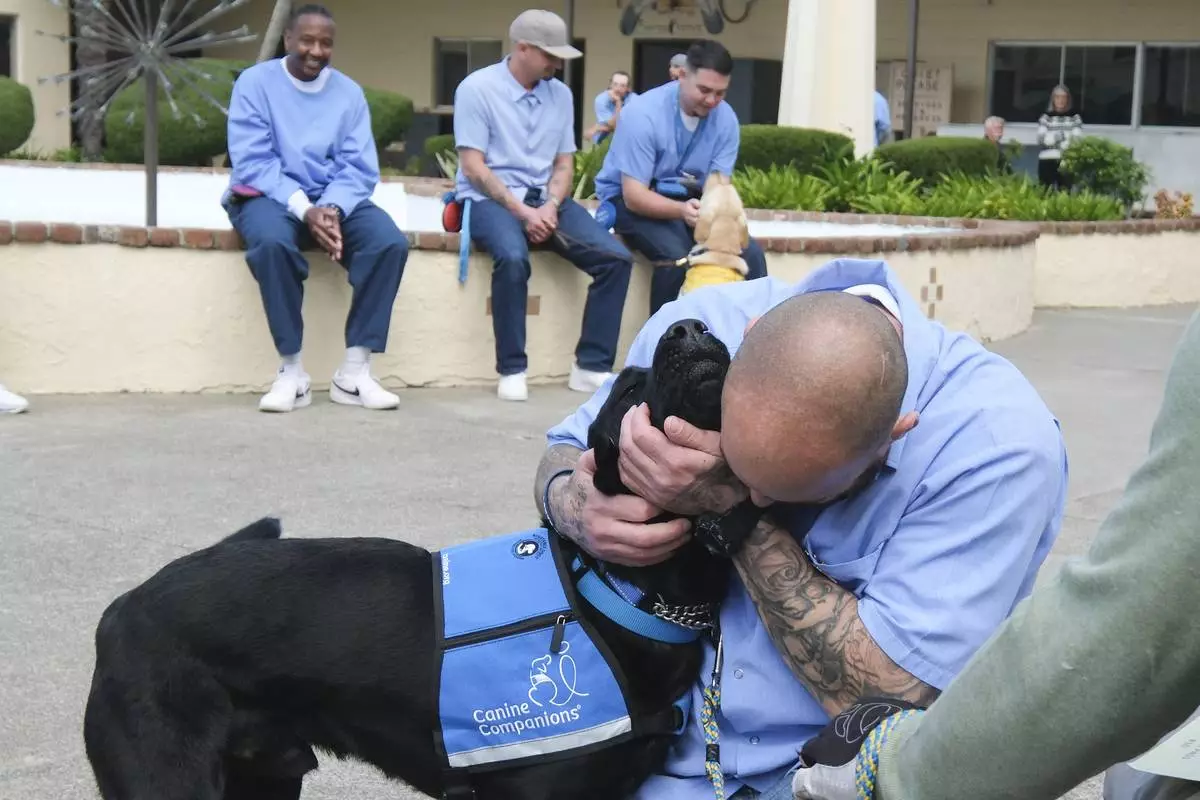
Jared Hansen, who is incarcerated at the San Quentin Rehabilitation Center, is greeted by Artemis, a service dog he helped train, in San Quentin, Calif., Friday, March 28, 2025. (AP Photo/Eric Risberg)
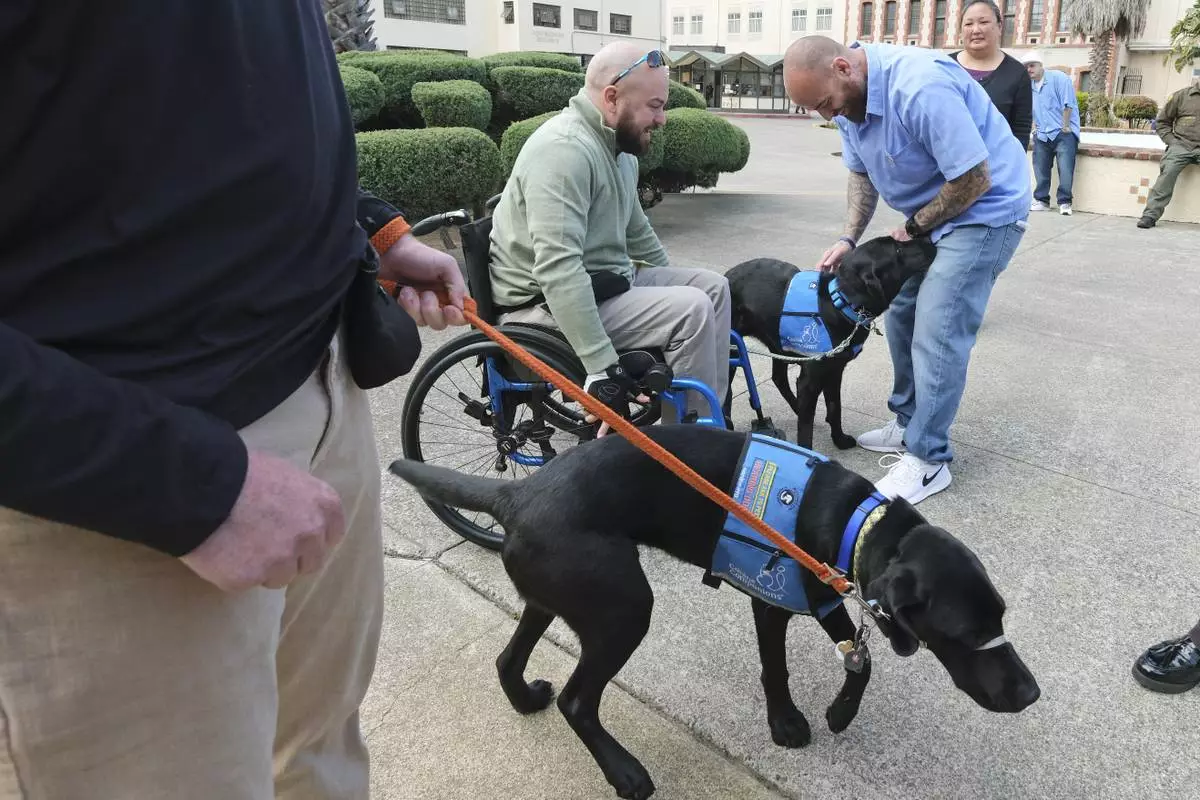
Jared Hansen, right, who is incarcerated at the San Quentin Rehabilitation Center, visits with Artemis as his handler, Benjamin Carter, looks on in San Quentin, Calif., Friday, March 28, 2025. (AP Photo/Eric Risberg)
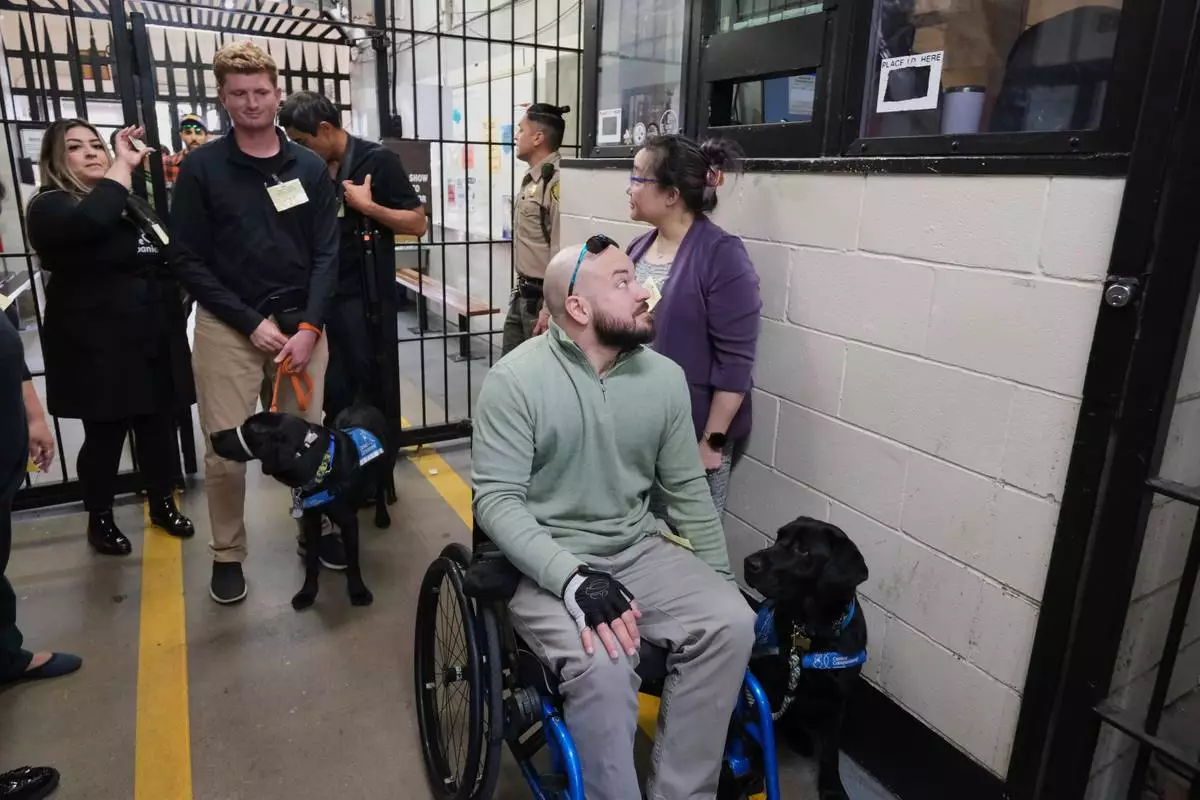
Benjamin Carter, in a wheelchair, with his service dog Artemis, and Robert Quigley, who is deaf, with his service dog Wendel, go through a secure entryway into the San Quentin Rehabilitation Center in San Quentin, Calif., Friday, March 28, 2025. (AP Photo/Eric Risberg)
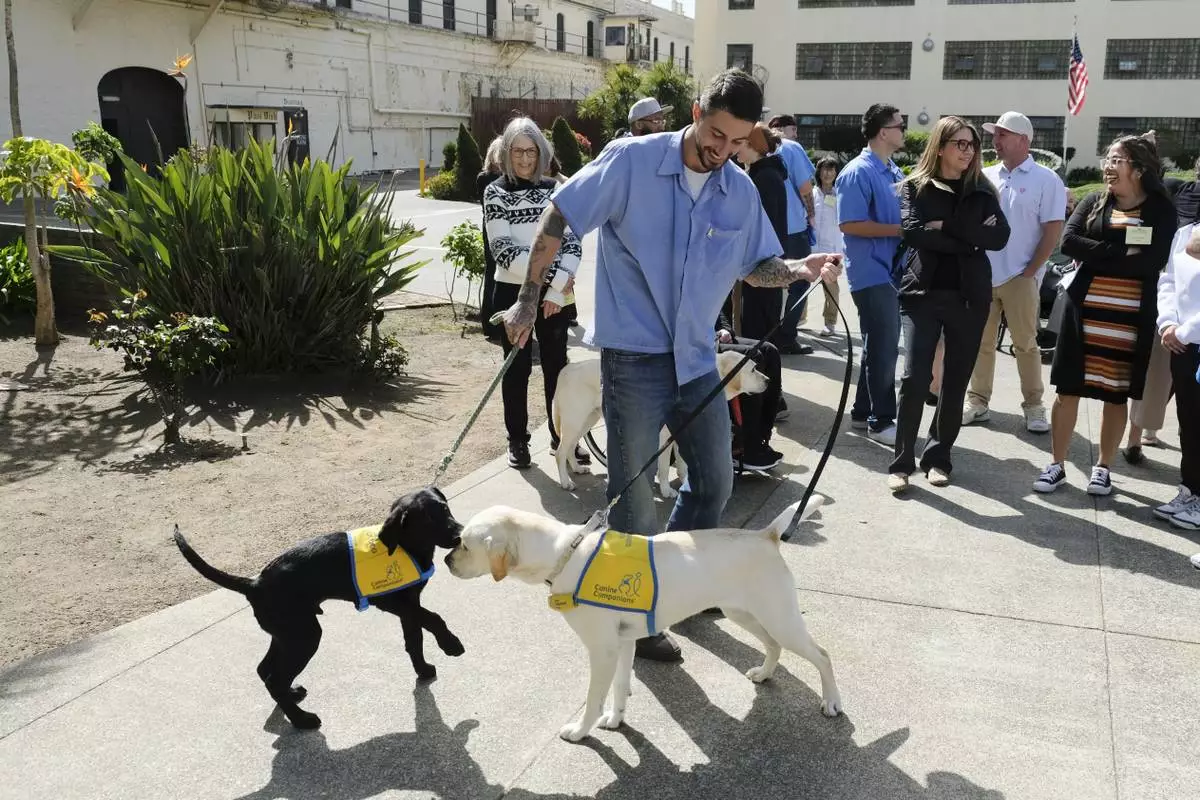
Chase Benoit, who is incarcerated at the San Quentin Rehabilitation Center, holds a pair of service dogs in training in San Quentin, Calif., Friday, March 28, 2025. (AP Photo/Eric Risberg)
DUBAI, United Arab Emirates (AP) — Suspected U.S. airstrikes over the weekend targeting Yemen's Houthi rebels killed at least six people, the group said Sunday, while a bombing video posted by U.S. President Donald Trump suggested casualties in the overall campaign may be higher than the rebels acknowledge.
A strike Sunday night in Sanaa, the rebel-held capital of Yemen, hit a house, killing at least four people and wounding 16 others, the Houthis said. Their al-Masirah satellite news channel showed images of the damaged home and people receiving care in a hospital.
The strike on the house in Sanaa's Shu’ub district allegedly targeted a Houthi leader, part of a wider decapitation campaign launched by the Trump administration to kill rebel leaders. The intense campaign of U.S. airstrikes targeting the rebels over their attacks on shipping in Mideast waters — related to the Israel-Hamas war — has killed at least 73 people, according to casualty figures released by the Houthis.
Earlier Sunday, the Iranian-backed Houthis said other suspected U.S. airstrikes killed at least two people in the rebel stronghold of Saada and wounded nine others. Footage aired by al-Masirah showed a strike collapsing what appeared to be a two-story building. The rebels aired no footage from inside the building, which they described as a solar power shop.
The Houthis have not acknowledged any casualties among their security and military leadership — something challenged after an online video posted by Trump.
Early on Saturday, Trump posted what appeared to be black-and-white video from a drone showing over 70 people gathered in a circle. An explosion detonates during the 25-second video. A massive crater is left in its wake.
“These Houthis gathered for instructions on an attack,” Trump claimed, without offering a location or any other details about the strike. “Oops, there will be no attack by these Houthis! They will never sink our ships again!”
The U.S. military's Central Command, which oversees Mideast military operations, has not published the video nor offered specific details about the strikes it has conducted since March 15. The White House has said over 200 strikes have targeted the Houthis.
The rebel-controlled SABA news agency in Yemen, citing an anonymous source, described the bombing as targeting “a social Eid visit in Hodeida governorate.” Muslims around the world just celebrated Eid al-Fitr at the end of the holy Muslim fasting month of Ramadan. SABA had published images of other commanders meeting fighters during the holiday, though not any high-level Houthi officials.
“Those present at that gathering had no connection to the operations carried out by the (Houthis), which are implementing the decision to ban navigation on ships linked to the American and Israeli enemy,” the SABA report said, adding that the attack killed and wounded “dozens.”
The Houthis previously have not acknowledged any strike on Hodeida during that time with such a high casualty count. The SABA report also did not describe those killed as civilians, suggesting they did have ties to the rebels' security or military forces. Hodeida has been a site of Houthi attacks into the Red Sea.
Moammar al-Eryani, the information minister for Yemen's exiled government opposing the Houthis, claimed the strike killed some 70 Houthi fighters and leaders, as well as “experts” from Iran's paramilitary Revolutionary Guard. He offered no evidence for the claim, though Iran has backed the Houthis. Neither the Iranian government nor the Guard has acknowledged the attack.
Mohammed al-Basha, a Yemen expert of the Basha Report risk advisory firm, cited social media condolence notices suggesting a colonel overseeing police stations for the Houthis in Hodeida had been killed in the strike Trump highlighted, alongside his two brothers.
“The strikes have expanded significantly, hitting multiple governorates simultaneously, alongside telecommunications infrastructure, command nodes, properties tied to senior Houthi leadership and previously untouched tunnel networks in mountainous areas,” al-Basha told The Associated Press.
“We’ve also seen direct targeting of Houthi force gatherings, indicating a more aggressive and evolving shift in the targeting strategy,” al-Basha said.
An AP review has found the new U.S. operation against the Houthis under Trump appears more extensive than those under former President Joe Biden, as Washington moves from solely targeting launch sites to firing at ranking personnel and dropping bombs on cities.
The new campaign of airstrikes started after the rebels threatened to begin targeting “Israeli” ships again over Israel blocking aid entering the Gaza Strip. The rebels have loosely defined what constitutes an Israeli ship, meaning many vessels could be targeted.
The Houthis targeted more than 100 merchant vessels with missiles and drones, sinking two of them and killing four sailors from November 2023 until January of this year. They also launched attacks targeting American warships without success.
The attacks greatly raised the profile of the Houthis, who faced economic problems and launched a crackdown targeting dissent and aid workers in Yemen amid a decadelong stalemated war that has torn apart the Arab world’s poorest nation.
The U.S. campaign shows no signs of stopping, as the Trump administration has linked its airstrikes on the Houthis to an effort to pressure Iran over its rapidly advancing nuclear program.
Associated Press writer Samy Magdy in Cairo contributed to this report.
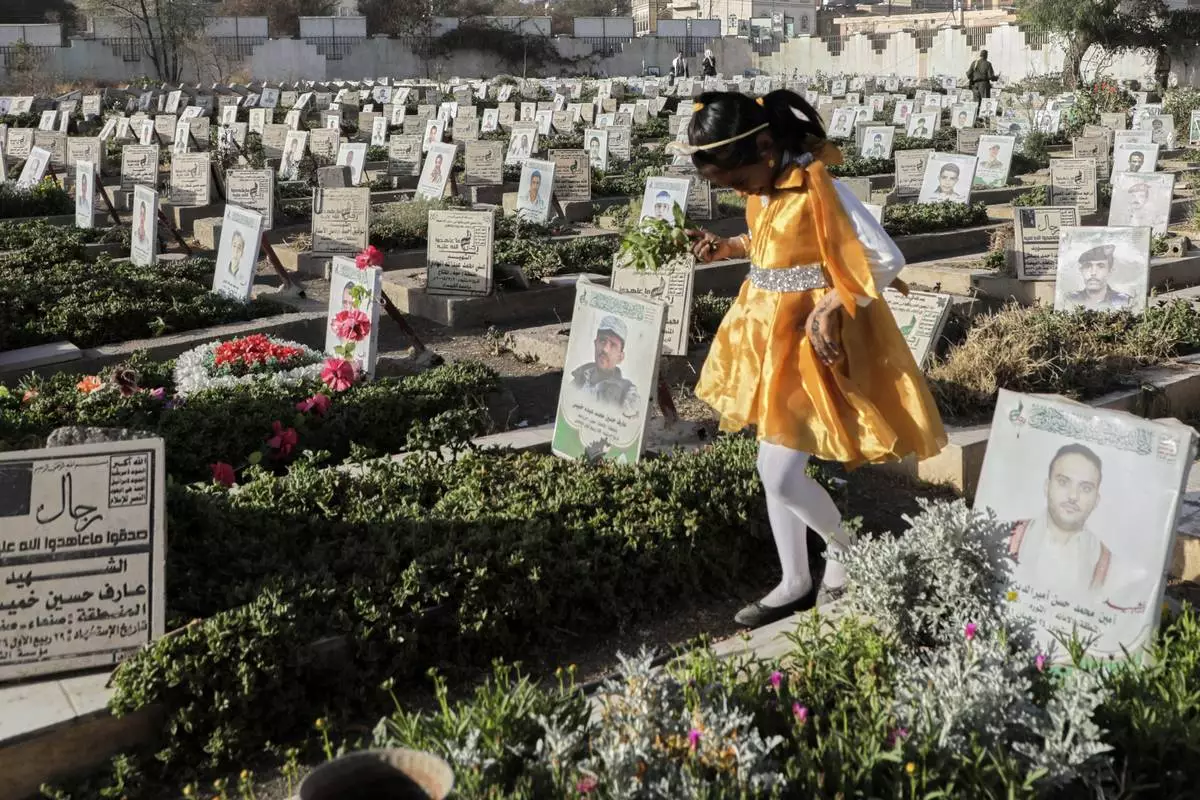
A Yemeni girl visits the graves of Houthis during Eid al-Fitr marking the end of the holy fasting month of Ramadan in Sanaa, Yemen, Sunday, March 30, 2025. (AP Photo/Osamah Abdulrahman)












